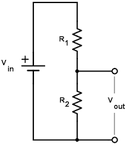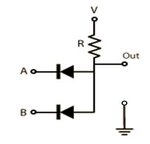TotalNoob
Newbie level 4
Hi, my problem is that i understand circuits like that:

I can see where where the starting + and - of the battery would be, also i can see where the output is. It is really simple. But then, in school they showed me this

And they tell me that this works like AND gate. I dont understand how V is only one wire, and i have problems understanding how it works at all.
My question is: Does this way of presenting circuits have its own name?
Thank you for any potential help.

I can see where where the starting + and - of the battery would be, also i can see where the output is. It is really simple. But then, in school they showed me this

And they tell me that this works like AND gate. I dont understand how V is only one wire, and i have problems understanding how it works at all.
My question is: Does this way of presenting circuits have its own name?
Thank you for any potential help.
